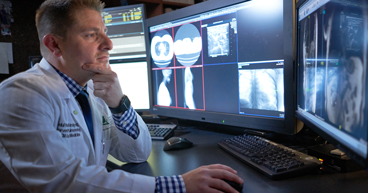
Lung cancer may make every breath you take a struggle and drain you physically when you perform even small tasks. Finding a way to cope with the symptoms of lung cancer and the side effects of lung cancer treatment is critical to improving your quality of life before, during and after treatment.
If the subject hasn’t come up already, you may want to ask your oncologist if you’re a candidate for pulmonary rehabilitation, a medical therapy that teaches methods to help you avoid being short of breath or fatigued. It also offers assistance in dealing with the anxiety, pain and depression cancer may be causing.
“The goal of pulmonary rehabilitation is to educate patients on the side effects of their treatments and give them tools to manage those side effects,” says Mirela Holtz, Physical Therapist at City of Hope Phoenix. Pulmonary rehab isn’t cancer treatment, but it may help your body respond better to treatment—whether you’re undergoing chemotherapy, radiation therapy, immunotherapy or lung cancer surgery—while also aiding your recovery process.
“We want to enhance patients’ pulmonary status through postural re-education, through manual therapy to reduce scar tissue and desensitize nerve-related pain, and through therapeutic exercise to restore muscle balance,” Holtz says.
In this article, we’ll explore the potential benefits of pulmonary rehabilitation for cancer patients. Topics include:
- What is pulmonary rehabilitation?
- How should you be breathing?
- Other aspects of pulmonary rehab
- Who’s on your pulmonary rehabilitation team?
- What are the benefits of pulmonary rehab?
- Are there risks with pulmonary rehabilitation?
- What to wear or bring to pulmonary rehabilitation
- Is pulmonary rehabilitation for you?
If you believe you may be experiencing signs of lung cancer and want to schedule a consultation, or if you’re interested in a second opinion on your diagnosis and treatment plan, call us or chat online with a member of our team.
What is pulmonary rehabilitation?
Pulmonary rehabilitation was first used to help people with symptoms of chronic obstructive pulmonary disease (COPD), a lung disease that causes breathlessness. The therapy’s application has expanded to other chronic lung diseases that may cause difficulty breathing or weakened muscles due to lack of physical activity. These lung conditions include:
- Asthma
- Bronchiectasis
- Chronic bronchitis
- Cystic fibrosis
- Emphysema
- Pulmonary fibrosis
- Lung cancer
Pulmonary rehabilitation is composed of exercises that seek to improve breathing techniques to reduce shortness of breath, increase airflow, strengthen muscles that are associated with breathing and improve overall lung health.
“When you become short of breath, you become highly anxious, and your body tries to kick into that fight-or-flight instinct we have,” says Betti Grab, Cardiopulmonary Manager at City of Hope Phoenix. “Your heart rate goes up, your respiratory rate goes up, and the body is on high alert. You may start sweating. You’ll notice that you’re warm, you’re feeling your heart beating a little faster. You may feel some palpitations.”
Pulmonary rehabilitation teaches ways to stop that panic and get the body to consume more oxygen. “You’re just trying to relax, calm down and let your body do what it’s supposed to do,” Grab says.
How should you be breathing?
Some breathing techniques that may be taught during pulmonary rehab include:
Pursed-lip breathing: Patients learn to breathe in through their noses and out slowly through their mouths, with only a small separation between their lips—like you’re trying to whistle. Pursed-lip breathing may alleviate the feeling of being short of breath while slowing down your breathing rate. The technique helps keep the airways in the lungs open longer.
Diaphragmatic breathing: Patients learn to carry oxygen deeper into their bodies by pulling air into the abdominal region. Also called abdominal breathing or belly breathing, this technique helps strengthen the stomach muscles at the same time it gets the lungs working more efficiently.
4-7-8 breathing: In this exercise, patients use pursed-lip breathing, but with measured patterns. They begin by inhaling for four seconds, holding their breath for seven seconds, then exhaling for eight seconds.
Mindful breathing: While other breathing techniques may help reduce anxiety and stress, mindful breathing is the most meditative. Patients find a quiet, comfortable spot and begin pursed-lip breathing while focusing on something that makes them happy. While doing this exercise, patients should practice exhaling for twice as long as they inhale.
Other aspects of pulmonary rehab
Exercise training is designed to teach you energy-conserving techniques to limit how much you’re lifting, reaching or bending, which put stress on the lungs. Your team may also monitor your oxygen levels, blood pressure and heart rate during exercises to help measure your progress.
Another aspect of pulmonary rehabilitation focuses on nutrition. One-third or more of lung cancer patients may be malnourished, which may impact their health and limit their ability to undergo cancer treatments. Weight loss is also common. That’s why pulmonary rehab includes information about healthy, nutritious diets and how to sustain your body weight.
Who’s on your pulmonary rehabilitation team?
Because pulmonary rehabilitation addresses many of the symptoms and side effects you may be experiencing, it calls for a multidisciplinary approach. Team members may include:
- Physician
- Nurse
- Respiratory therapist, who teaches breathing strategies to open airways, expand the lungs and increase airflow
- Physical therapist, who helps improve endurance and muscle strength, increasing stamina so the patient is better able to perform daily activities
- Occupational therapist or a therapist that restores activities of daily living, who teaches energy-saving techniques and ways to breathe easier
- Social worker, who provides assistance in securing financial support to pay for the therapy, teaches patients and family members about the importance of quitting smoking and avoiding activities or exposures that may worsen symptoms, and helps patients understand the importance of having a support group of family and friends to assist with limitations they may be experiencing
- Dietitian or nutritionist, who offers nutritional counseling and eating plans to help manage weight and build muscle mass
- Psychologist or behavioral health provider, who helps manage depression, anxiety and overall mental health
“We may see patients shortly after they’re diagnosed with lung cancer for assessment of their baseline data, measuring their functional endurance, strength and other attributes; during chemotherapy and radiation therapy, while they’re getting fatigued and weaker; or post-operatively, when we address postural changes and pain issues and correct breathing techniques.” Holtz says. “We may even see patients as they enter survivorship to guide them on healthy habits and safe exercise to reduce their chance of recurrence.”
What are the benefits of pulmonary rehab?
The benefits of pulmonary rehab for lung cancer patients may include:
- Reduced shortness of breath
- Less fatigue
- Reduced pain
- Improved strength and endurance
These changes may help lead to a more active lifestyle, decreased depression and less anxiety. Pulmonary rehab may also help medications you’re taking work better, teach you how to use supplemental oxygen and give you an incentive to quit smoking.
Nutritional management may go a long way toward addressing your quality of life and avoiding weight loss, which is common among lung cancer patients. Simply put, if you’re having trouble breathing, you may be too tired to eat or less concerned about eating healthy.
Some lung cancer patients may require pulmonary rehab to improve their lung function, increase their tolerance for surgery and make them eligible for lung surgery. Improving posture through rehabilitation may help restore muscle balance, by “strengthening what’s weak and stretching what’s tight,” Holtz says.
“Our posture changes with age and reduced activity levels. It also changes if you have surgery through the chest wall due to lung cancer,” she adds. “Scar tissue builds up, and pain permits the body to hold only certain postures. Rehab providers work to reduce the pain and restore normal posture.”
Manual therapy on the body’s soft tissues breaks down the abnormal alignment of collagen fibers and softens the scar lines left by surgical incisions.
“When nerves are cut, it may produce hypersensitivity and pain,” Holtz says. “Massage and introducing different pressures and textures over the painful area speed up the healing process of the damaged nerves.”
Are there risks with pulmonary rehabilitation?
Though pulmonary rehabilitation is generally considered safe, there are risks you should consider. In rare cases, the National Institute of Health says, the physical activity performed as part of the program may injure the patient’s muscles or bones, potentially even causing a bone fracture. “If serious problems occur during the supervised sessions, your pulmonary rehabilitation team will stop the physical activity right away, give you the appropriate treatment, and contact your doctor,” the NIH says.
Also, patients with severe pulmonary hypertension or unstable heart disease, or those who’ve recently had surgery, should be particularly careful and use a therapist to ensure that therapeutic exercises are performed safely.
Because of these concerns, pulmonary rehab should be supervised by an experienced health care provider.
What to wear or bring to pulmonary rehabilitation
- Wear comfortable clothing and shoes to your sessions. Athletic or loose-fitting clothing are appropriate, since you may be exercising.
- It’s also good to have something to drink on hand to keep you hydrated during the session.
- Bring any medications that may be needed, or an inhaler if you use one.
- You may even want to bring a family member or friend with you to offer support as you go through the therapy.
Is oncology rehabilitation for you?
Pulmonary rehabilitation is one of many oncology rehabilitation services offered at City of Hope.
The COPD Foundation recommends seeking a referral to a pulmonary rehabilitation program that has trained staff, a supervised exercise program and a formal education program.
Oncology rehabilitation at City of Hope includes a wide variety of therapies designed to help patients manage cancer-related symptoms or side effects and build strength, reduce stress and maintain the energy needed to continue treatment uninterrupted and participate in daily activities.
Symptoms and side effects oncology rehabilitation may be used to help manage include:
- Anxiety and stress
- Fatigue
- Immobility
- Lymphedema
- Pain
Your oncology rehabilitation team may include licensed physical therapists, occupational therapists, and speech and language pathologists. Some patients may find that oncology rehabilitation services help them stay strong, support their immune system, manage side effects and maintain their well-being.
If you believe you may be experiencing signs of lung cancer and want to schedule a consultation, or if you’re interested in a second opinion on your diagnosis and treatment plan, call us or chat online with a member of our team.




